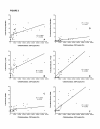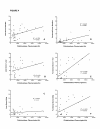Chitotriosidase as a biomarker of cerebral adrenoleukodystrophy
- PMID: 22014002
- PMCID: PMC3236018
- DOI: 10.1186/1742-2094-8-144
Chitotriosidase as a biomarker of cerebral adrenoleukodystrophy
Abstract
Background: Adrenoleukodystrophy (ALD) is an X-linked peroxisomal disorder characterized by the abnormal beta-oxidation of very long chain fatty acids (VLCFA). In 35-40% of children with ALD, an acute inflammatory process occurs in the central nervous system (CNS) leading to demyelination that is rapidly progressive, debilitating and ultimately fatal. Allogeneic hematopoietic stem cell transplantation (HSCT) can halt disease progression in cerebral ALD (C-ALD) if performed early. In contrast, for advanced patients the risk of morbidity and mortality is increased with transplantation. To date there is no means of quantitating neuroinflammation in C-ALD, nor is there an accepted measure to determine prognosis for more advanced patients.
Methods: As cellular infiltration has been observed in C-ALD, including activation of monocytes and macrophages, we evaluated the activity of chitotriosidase in the plasma and spinal fluid of boys with active C-ALD. Due to genotypic variations in the chitotriosidase gene, these were also evaluated.
Results: We document elevations in chitotriosidase activity in the plasma of patients with C-ALD (n = 38; median activity 1,576 ng/mL/hr) vs. controls (n = 16, median 765 ng/mL/hr, p = 0.0004), and in the CSF of C-ALD patients (n = 38; median activity 4,330 ng/mL/hr) vs. controls (n = 16, median 0 ng/mL/hr, p < 0.0001). In addition, activity levels of plasma and CSF chitotriosidase prior to transplant correlated with progression as determined by the Moser/Raymond functional score 1 year following transplantation (p = 0.002 and < 0.0001, respectively).
Conclusions: These findings confirm elevation of chitotriosidase activity in patients with active C-ALD, and suggest that these levels predict prognosis of patients with C-ALD undergoing transplantation.
Figures




Similar articles
-
[X-linked adrenoleukodystrophy].Ann Endocrinol (Paris). 2007 Dec;68(6):403-11. doi: 10.1016/j.ando.2007.04.002. Epub 2007 May 29. Ann Endocrinol (Paris). 2007. PMID: 17532287 Review. French.
-
Metformin-induced mitochondrial function and ABCD2 up-regulation in X-linked adrenoleukodystrophy involves AMP-activated protein kinase.J Neurochem. 2016 Jul;138(1):86-100. doi: 10.1111/jnc.13562. Epub 2016 Mar 14. J Neurochem. 2016. PMID: 26849413
-
Treatment of cerebral adrenoleukodystrophy: allogeneic transplantation and lentiviral gene therapy.Expert Opin Biol Ther. 2022 Sep;22(9):1151-1162. doi: 10.1080/14712598.2022.2124857. Epub 2022 Sep 19. Expert Opin Biol Ther. 2022. PMID: 36107226 Review.
-
Progression of abnormalities in adrenomyeloneuropathy and neurologically asymptomatic X-linked adrenoleukodystrophy despite treatment with "Lorenzo's oil".J Neurol Neurosurg Psychiatry. 1999 Sep;67(3):290-9. doi: 10.1136/jnnp.67.3.290. J Neurol Neurosurg Psychiatry. 1999. PMID: 10449548 Free PMC article. Clinical Trial.
-
The effect of Lorenzo's oil on oxidative stress in X-linked adrenoleukodystrophy.J Neurol Sci. 2006 Sep 25;247(2):157-64. doi: 10.1016/j.jns.2006.04.004. Epub 2006 Jun 5. J Neurol Sci. 2006. PMID: 16750542 Clinical Trial.
Cited by
-
Glycoprotein nonmetastatic melanoma protein B (GNMPB) as a novel biomarker for cerebral adrenoleukodystrophy.Sci Rep. 2022 May 14;12(1):7985. doi: 10.1038/s41598-022-11552-7. Sci Rep. 2022. PMID: 35568699 Free PMC article.
-
Neurocognitive Trajectory of Boys Who Received a Hematopoietic Stem Cell Transplant at an Early Stage of Childhood Cerebral Adrenoleukodystrophy.JAMA Neurol. 2017 Jun 1;74(6):710-717. doi: 10.1001/jamaneurol.2017.0013. JAMA Neurol. 2017. PMID: 28418523 Free PMC article.
-
Glucosylsphingosine is a highly sensitive and specific biomarker for primary diagnostic and follow-up monitoring in Gaucher disease in a non-Jewish, Caucasian cohort of Gaucher disease patients.PLoS One. 2013 Nov 20;8(11):e79732. doi: 10.1371/journal.pone.0079732. eCollection 2013. PLoS One. 2013. PMID: 24278166 Free PMC article.
-
Elevated cerebral spinal fluid biomarkers in children with mucopolysaccharidosis I-H.Sci Rep. 2016 Dec 2;6:38305. doi: 10.1038/srep38305. Sci Rep. 2016. PMID: 27910891 Free PMC article.
-
A Rare Cause of Elevated Chitotriosidase Activity: Glycogen Storage Disease Type IV.JIMD Rep. 2014;17:63-6. doi: 10.1007/8904_2014_335. Epub 2014 Aug 26. JIMD Rep. 2014. PMID: 25155778 Free PMC article.
References
-
- Mahmood A, Dubey P, Moser HW, Moser A. X-linked adrenoleukodystrophy: therapeutic approaches to distinct phenotypes. Pediatr Transplant. 2005;9(Suppl 7):55–62. - PubMed
-
- Cartier N, Hacein-Bey-Abina S, Bartholomae CC, Veres G, Schmidt M, Kutschera I, Vidaud M, Abel U, Dal-Cortivo L, Caccavelli L. et al.Hematopoietic stem cell gene therapy with a lentiviral vector in X-linked adrenoleukodystrophy. Science. 2009;326:818–823. doi: 10.1126/science.1171242. - DOI - PubMed
Publication types
MeSH terms
Substances
LinkOut - more resources
Full Text Sources
Research Materials

